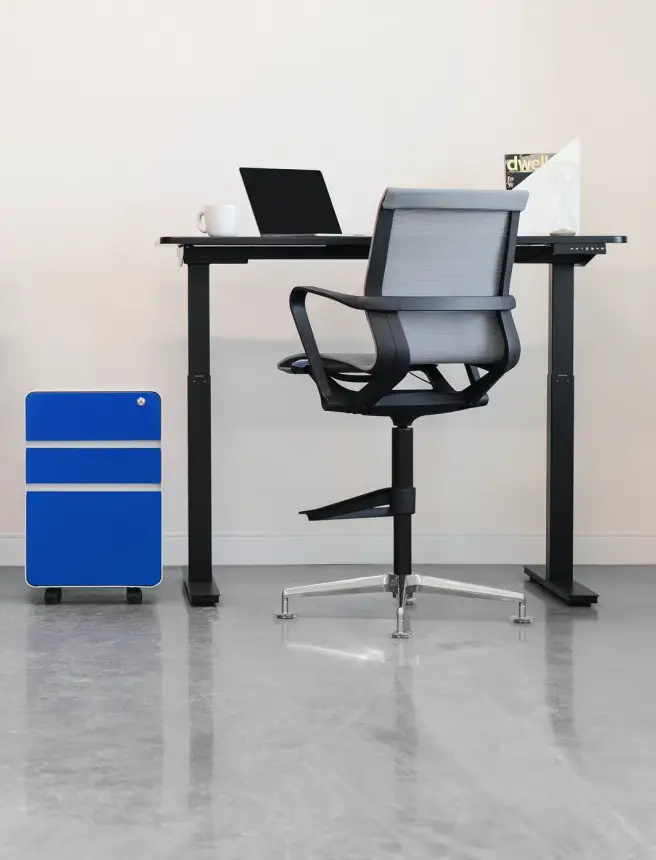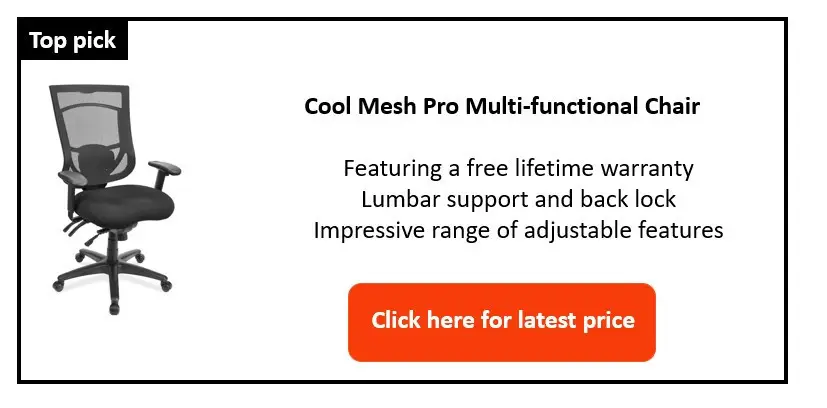If you have recently started using a standing desk, you may find that it is a bit tiring to stand while you work. Besides, standing for long periods has its own problem. A simple solution could be a leaning chair or stool. So, what is a standing desk chair?
Let’s dive right in and see what this latest innovation in the world of seating is all about!
Did you know? Standing desk chairs and stools are designed to be used for short periods of time. Source

What is a standing desk chair?
A standing desk chair allows users to lean on the chair in a position between sitting and standing while they are using a standing desk. This allowing them to rest in between these two positions. It also gives the user more flexibility in terms of the positions they can adopt as they can alternate between sitting, standing and leaning on the standing desk chair. They are most commonly available in the form of a standing desk stool, but standing desk chairs are also available. These are sometimes referred to as leaning chairs, leaning stools or wobble stools.
If you’re still struggling with the concept of a sit stand chair, imagine yourself sitting on a stool with your feet on the floor. Now picture the stool tilting with you as if you’re leaning in to see something. That’s the simplest way I can think of describing it to you.
How to use a leaning chair?
To use a standing desk chair, stand with the chair about 1 foot behind you. Lean the seat forward until it’s at the desired angle. Once you are ready to lean on it, release the lever so that the sit stand seat is at a level where you can place your weight against the seat at an angle. Then position your feet at a comfortable angle so that you’re forming the shape of the letter ‘A’ with the chair.
Some people have the standing chair positioned at a tilt already which means that they simply need to stand in front of the chair, raise their height by standing on the balls of their feet and then sit onto the chair. The seat pan tends to lower with the weight of the user.
To dismount from the seat, bring a foot backwards towards the seat while leaning back to lift yourself off the seat.
The majority of leaning chairs are designed to be used in a perched position. However, some standing desk chairs offer a range of positions including:
- Wall: Seat pan is at an upright vertical position to mimic leaning against a wall.
- Seated: The user can sit on the standing desk chair the same as a normal stool or chair.
- Lumbar: The seat pan is in a horizontal orientation and positioned at lumbar level so that the user can rest the lumbar (lower back) region against it.
Why use a standing desk chair?
Instead of encouraging people to either sit or stand, the leaning desk chair offers you the ability to have an in-between option of leaning. Since we repeatedly hear how important movement and avoiding static postures is for the body, the leaning desk chair offers yet another alternative to merely sitting or standing.
Since standing imposes a lot of pressure on our body to maintain this posture, people often become tired easily. Conversely, sitting can also induce a tiring effect and since it takes more effort to move around from a seated position than a standing position, we may be less inclined to get up from our comfy office chair. This is where the perching position mixes sitting with standing.
Features of a standing desk chair
Seat fabric: The seat comes in a variety of materials, such as:
- Fabric
- Vinyl
- Plastic
- EVA foam
A fabric finish is often more comfortable to touch; however, it can be more difficult to clean. Vinyl is easier to clean.
EVA foam is also a common material used for the seat fabric. For any of you that are unfamiliar with the name, it’s essentially the same type of rubbery material that is used in a bicycle seat or even hockey pads. It gives a firm finish and is relatively easy to clean.
In terms of plastic, polypropylene is a popular finish to the seat pan itself as it’s durable and easy to clean.
Seat cushioning: The seat padding echoes those of a standard office chair. The seat pans can come padded with a foam for a soft effect. However, the most popular type of seat with standing chairs is a firm padding style. From reviews of sit stand chairs with a firm seat, the reviewers tended to find that they were often too stiff, and this caused them discomfort.
Seat tilt: The seat pan is equipped with a tilt function so that the user can adjust it to their preferred angle. Some seats allow set tilt angles, such as 15 degrees, 45 degrees and 90 degrees. Some people may find this restrictive, particularly if the seat angles don’t accommodate their position adequate.
Seat shape: Seats primarily come in 2 forms, concave and convex. The concave style seats curve inwards while the convex seat curves outwards to form a semi-circle top. The convex seat is often found on padded seats.
Some seats form the shape of a saddle, which is intended to alleviate leg pressure along with fitting the hip curve. This type of seat might be one that some people find uncomfortable, especially males.
It’s also worth noting that many of the seat pans are relatively small, which some users may find difficult to balance on or adjust to. For instance, the Vari Active Seat is 17 inches wide and 13 inches long.
Height lever: Similar to any other desk chair, sit stand chairs and stools also feature the ability to adjust the height to accommodate the user. This is commonly by means of a gas lift lever. It may be fitted to the pedestal or it may take the form of push buttons underneath the seat.
Non-slip base: The base on standing desk chairs is often in the shape of a circle or square which the user pivots from as they lean or perch on the chair. The base of the wobble stool partially lifts off the ground with the user. With other leaning chairs, the base remains firmly positioned on the floor and doesn’t lift with the user.
If the chair is equipped with an anti-fatigue mat, this completely alters the shape of the entire base. The anti-fatigue mat is often attached to the base of the unit which can be moved around and often has wheels provided. When I saw one first, I thought it looked a bit like a scooter.
Some chairs are equipped with a very narrow base, which isn’t all that far off a pogo stick! However, these are less common on the market.
While the base design of a standing desk chair varies, they are all equipped with a non-slip surface to minimize unwanted movement while you perch yourself on the chair. The base is also designed with the intention of preventing damage to the flooring.
Anti-fatigue mat: Some of the elite standing chairs come equipped with an anti-fatigue mat that helps alleviate the pressure on your legs and feet that often accompanies standing or leaning on them.
Assembly: Most leaning chairs and stools offer an out-of-the-box approach, so essentially, they require little to no assembly. If assembly is required, it tends to involve attaching the rod to the base and to the seat.
How much do standing desk chairs weigh?
Standing desk chairs weigh an average of 20.17 – 28 pounds. This applies to chairs that have no arms or backrest. If the standing desk chair has an anti-fatigue mat fitted, the weight can increase significantly up to 37 pounds or higher.
Are standing desk chairs any good?
Standing desk chairs are good for promoting movement while you work at a standing desk. They consume less space than an office chair and tend to be cheaper, lighter and more portable than an office chair too. However, standing chairs are not designed for use over a long period of time. Leaning chairs also tend to be less comfortable to use, and some people may find them more difficult to use, especially if they have poor balance. Finally, they have a limited weight capacity, some of which can reach up to 275 pounds, so they are not suitable for everybody.
Conclusion
As trendy seat fads go, a standing chair is certainly one of the better ones. Although it takes some getting used to, many users have positive feedback in relation to their experience.
However, it’s also evident that standing desk chairs are not for everybody. So, if you prefer to opt for a traditional style of chair with ergonomic features, here’s one that I personally love: CoolMesh Pro Multi-Function Chair It even comes with a huge lifetime warranty! You would be lucky to even get a 3-year warranty with some chairs these days!

If you’re like one of thousands of people looking to escape the limiting positioning that a standard desk offers, but the thought of a wobble chair is slightly daunting to you, then perhaps a standing desk converter is more in your line. These are much more popular and a sturdy option which enables both sitting and standing positions without the extensive expense of a whole new desk. If this sounds like an option for you, or you just want to open your mind to the best and innovative advances in furniture, then go check out 5 types of standing desk converters – ultimate cheat sheet!
My aim with this website is to help you on all matters associated to your home office and your work area. With that in mind, if you have any queries or comments on the above, please drop them in the box below. I’d love to hear them.
